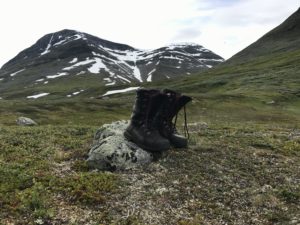
Probably the most important choice for a successful and pleasant hike is which shoes to wear. As much as taste and personal preference plays in there are a few things to consider.
We will here discuss different types of shoes and when to use which.
- Shoes v/s Boots – naturally boots are the best choice in wet and muddy conditions, when we face an abundance of shallow streams we need to cross and in rocky terrain where the extra support for feet and ancles is needed. Other than that we can roll by the rule of thumb that “the lighter the shoe, the faster the hike”. It just seems to be so much easier to move in light shoes than heavy boots!
- Leather v/s membranes – here we find ourselves completely in the realm of personal preference, some people swear on GoreTex while other swear at it. Basically the membrane shoe takes less work to keep you dry initially yet doesn’t even come close to the durability of a well maintained leather boot. The membrane tends to get clogged after some time leaving us with a shoe that doesn’t breath at all any more. On the other hand the repeated wear and tear of folding at the same spot every step we take tends to make it break and now the shoe has a leak. Plain leather shoes need more work greasing and waxing to keep them water resistant, on the other hand they can last for years to come if they’re properly taken care of. I’ve tried both and finally went back to plain leather after 8 years of membrane trouble. So, if you’re willing to put some work into your footwear and carry a small can of wax and/or grease I’d clearly recommend to ditch the membranes, they’re just not worth the downsides.
- Stability – as mentioned above the nature of the activity demand different sturdiness of boots. The soft shoes used for easy conditions left aside there are four different categories of hiking boots – A,B,C and D, A being most lightweight and soft, D very stable and used more or less exclusively with crampons and other special equipment. To cover most hiking areas I’d recommend a pair in the B/C category, enabling the use of crampons while still smooth enough for comfortable hiking under easier conditions and serving as winter boots in moderate climates.
Now, if you’ve been following me for some time you probably know about my love fore minimalistic barefoot shoes and, frankly, I’m using these as often as I can in my everyday life and on hikes. Just recently I found a pair of VivoBarefoot boots and tried them on for a weekend hike. They totally exceeded my expectations and I can not recommend them enough for easier trails and moderate packs.
For a full review of the shoe, click here!
Well, that’s about it – remember there’s no shoe that fits everyone and make sure that you really try your new ones out thoroughly. Being out in the wild and finding out that you have a bad fit and end up with blisters is a bad idea!
Good luck, have fun and love the experience!!!